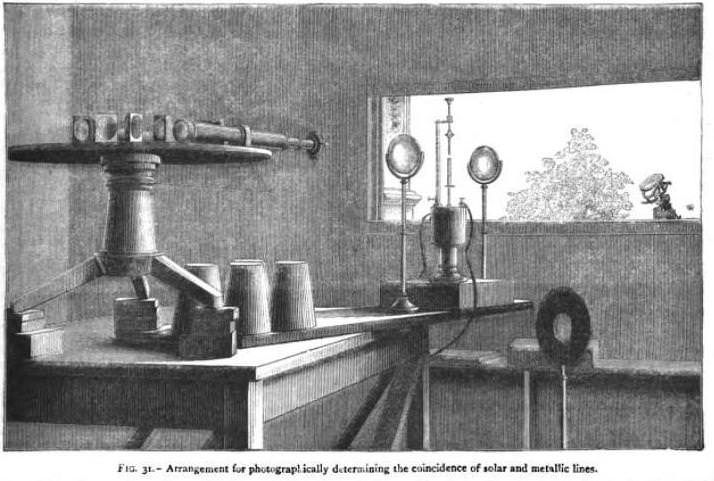[/caption]
Presently, I’ve been reading a lot of very old papers and books in astronomy. The work I’m currently reading a portion of, is from 1881, and is a summary of all the findings of the year in all fields of Science. For those that aren’t familiar with that time period in astronomy, the big thing was spectroscopy. It was only ~30 years earlier that chemists and astronomers had begun to work out methods by which to investigate spectra and with the newly developed tools in hand, astronomers were pointing them at anything they could find sufficiently bright to get a spectra. Obviously, this meant the first target was the Sun. This work provides an interesting snapshot at a developing era in astronomical history.
The article describes a brief bit of background, noting that the pioneering work of spectroscopy was done by Fraunhofer, Kirchoff, Angstrom, and Thalen (but manages to leave out Kirchoff’s colleague, Robert Bunsen!). These early explorers noted that, although spectral lines may appear unique, several had lines that would appear in very nearly the same positions.
Another discovery around that time was the phenomenon of emission lines from the Sun’s corona. This had officially been discovered in 1868 during a solar eclipse, but now that astronomers knew about the occurrence, they began to explore it further and discovered that many of the features had no apparent explanation as the chemicals causing them had yet to be discovered on Earth. Incidentally, it would be a year following this publication that helium, one of the chief components of the Sun, would be found and isolated on Earth.
As the astronomers explored the corona, they inspected the various layers and found a bizarre thing: Magnesium appeared higher in the corona than sodium despite magnesium having a higher atomic weight which astronomers realized, should cause it to sink. While this is not explained, I should note that spectra often play tricks like this. It may well have been that magnesium simply emits better at the temperatures in that region given an overestimation of the abundance. This odd behavior, as well as the inconstant nature of the spectra on various portions of the Sun was described as “a great screw loose”.
Another portion of the paper provides another somewhat humorous snapshot of this moment in history as the writer remarks just how different the Sun is from the Earth. He states, “It was difficult to imagine a stronger difference to exist between any two masses of matter than the chemical constitution of the incandescent sun, and of the earth, which is now cooling.” He wonders if perhaps planets evolved from failed stars in which the Sun’s “immense temperature had not allowed a complex evolution of higher complex forms of chemical matter to take place”. While this may seem quaint, the periodic table had only been developed 12 years prior and the creation of heavy elements would not be well understood until the 1950’s.
Similarly, the confusion on the varying spectral lines between stars is apparent although the author shows that the answers were already being developed, although still not fully fleshed out. He cites Angstrom stating: “In increasing successively the temperature I have found that the lines of the spectra vary in intensity in an exceedingly complicated way, and consequently new lines even may present themselves if the temperature is raised sufficiently high.”
In this single flash of insight, Angstrom had predicted a methodology by which astronomers could have begun to classify stars. Unfortunately, the standard of classification had already been set and it would take until the next century for astronomers to begin classifying stars by temperature (thanks to the work of Annie Jump Cannon). However, the author demonstrates that investigation was underway as to the relationship between temperature and line intensity. This work would eventually connect to our modern understanding of stellar temperatures.


